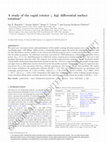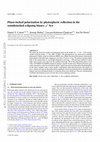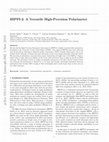Papers by Lucyna Chudczer
The Astrophysical Journal, 1995
We present ground-based observations of the BL Lac object PKS 2155-304 during 1991 November. Thes... more We present ground-based observations of the BL Lac object PKS 2155-304 during 1991 November. These data were obtained as part of a large international campaign of observations spanning the electro-magnetic spectrum from the radio waves to the X-rays. The data presented here include radio and UBVRI fluxes, as well as optical polarimetry. The U to I data show the same
ABSTRACT We propose to monitor the flux density of the Radio-Loud Narrow Line Seyfert 1 Galaxy, P... more ABSTRACT We propose to monitor the flux density of the Radio-Loud Narrow Line Seyfert 1 Galaxy, PKS 0558-504 to establish the possible interplay of the accretion disk and the radio jet in this source. PKS 0558-504 is currently being observed with the RXTE in the long-term monitoring campaign, which provides an important opportunity for the coordinated radio-X-ray observations. We will learn about the jet contribution to the X-ray emission and will compare the radio-X-ray properties of AGN with the known Galactic black holes.

Monthly Notices of the Royal Astronomical Society
We report new, extremely precise photopolarimetry of the rapidly-rotating A0 main-sequence star ζ... more We report new, extremely precise photopolarimetry of the rapidly-rotating A0 main-sequence star ζ Aql, covering the wavelength range ∼400–900 nm, which reveals a rotationally-induced signal. We model the polarimetry, together with the flux distribution and line profiles, in the framework of Roche geometry with ω-model gravity darkening, to establish the stellar parameters. An additional constraint is provided by TESS photometry, which shows variability with a period, Pphot, of 11.1 h. Modelling based on solid-body surface rotation gives rotation periods, Prot, that are in only marginal agreement with this value. We compute new ester stellar-structure models to predict horizontal surface-velocity fields, which depart from solid-body rotation at only the ∼2 per cent level (consistent with a reasonably strong empirical upper limit on differential rotation derived from the line-profile analysis). These models bring the equatorial rotation period, Prot(e), into agreement with Pphot, with...
American Astronomical Society Meeting Abstracts #233, 2019
The IAFOR International Conference on Technology in the Classroom - Hawaii 2016 - Official Conference Proceedings, Mar 11, 2016

Close binary systems often show linear polarization varying over the binary period, usually attri... more Close binary systems often show linear polarization varying over the binary period, usually attributed to light scattered from electrons in circumstellar clouds. One of the brightest close binary systems is Spica (Alpha Virginis) consisting of two B type stars orbiting with a period of just over 4 days. Past observations of Spica have shown low polarization with no evidence for variability. Here we report new high-precision polarization observations of Spica that show variation with an amplitude ~200 parts-per-million (ppm). Using a new modelling approach we show that the phase-dependent polarization is primarily due to reflected light from the primary off the secondary and vice versa. The stars reflect only a few per-cent of the incident light, but the reflected light is very highly polarized. The polarization results show that the binary orbit is clockwise and the position angle of the line of nodes is 130.4 +/- 6.8 degrees in agreement with Intensity Interferometer results. We su...

Monthly Notices of the Royal Astronomical Society, 2020
We report the detection of phase-locked polarization in the bright (mV = 2.98−3.24) semidetached ... more We report the detection of phase-locked polarization in the bright (mV = 2.98−3.24) semidetached eclipsing binary μ1 Sco (HD 151890). The phenomenon was observed in multiple photometric bands using two different HIPPI-class (HIgh Precision Polarimetric Instrument) polarimeters with telescopes ranging in size from 35 cm to 3.9 m. The peak-to-trough amplitude of the polarization is wavelength dependent and large, ∼700 ppm in green light, and is easily seen with even the smallest telescope. We fit the polarization phase curve with a synspec/vlidort polarized radiative transfer model and a Wilson–Devinney geometric formalism, which we describe in detail. Light from each star reflected by the photosphere of the other, together with a much smaller contribution from tidal distortion and eclipse effects, wholly accounts for the polarization amplitude. In the past, polarization in semidetached binaries has been attributed mostly to scattering from extra-stellar gas. Our new interpretation fa...

Publications of the Astronomical Society of Australia, 2020
We describe the High-Precision Polarimetric Instrument-2 (HIPPI-2) a highly versatile stellar pol... more We describe the High-Precision Polarimetric Instrument-2 (HIPPI-2) a highly versatile stellar polarimeter developed at the University of New South Wales. Two copies of HIPPI-2 have been built and used on the 60-cm telescope at Western Sydney University’s (WSU) Penrith Observatory, the 8.1-m Gemini North Telescope at Mauna Kea and extensively on the 3.9-m Anglo-Australian Telescope (AAT). The precision of polarimetry, measured from repeat observations of bright stars in the SDSS g′band, is better than 3.5 ppm (parts per million) on the 3.9-m AAT and better than 11 ppm on the 60-cm WSU telescope. The precision is better at redder wavelengths and poorer in the blue. On the Gemini North 8-m telescope, the performance is limited by a very large and strongly wavelength-dependent TP that reached 1000’s of ppm at blue wavelengths and is much larger than we have seen on any other telescope.
Astronomical & Astrophysical Transactions, 2007
The Astrophysical Journal, 2017
Monthly Notices of the Royal Astronomical Society, 2016
Symposium - International Astronomical Union, 2001
We discuss conditions which have to be satisfied for observable signatures of diffractive scintil... more We discuss conditions which have to be satisfied for observable signatures of diffractive scintillation in intraday variable (IDV) sources. We apply this discussion to the quasar PKS 0405-385 which had a scintillating component with angular size of 5 μas (Kedziora-Chudczer et al. 1997).
International Astronomical Union Colloquium, 1998
This is a progress report on the ATCA IDV survey of compact, flat or inverted spectrum radio sour... more This is a progress report on the ATCA IDV survey of compact, flat or inverted spectrum radio sources. We found that four sources: PKS 0405–385, PKS 1034–293, PKS 1144–397, and PKS 1519–273 out of the sample of 125 show high flux density variability on the daily timescale. The characteristics of observed IDV are discussed and we reflect on its possible origin.
Monthly Notices of the Royal Astronomical Society, 2016
Monthly Notices of the Royal Astronomical Society: Letters, 2016
Proceedings of the International Astronomical Union, 2013
Past analysis of HD 189733b's atmosphere has been a cause for some debate, with conflicting f... more Past analysis of HD 189733b's atmosphere has been a cause for some debate, with conflicting findings regarding water and sodium abundances and the presence of a high altitude haze. We present our models of HD…
Sources and Scintillations, 2001











Uploads
Papers by Lucyna Chudczer